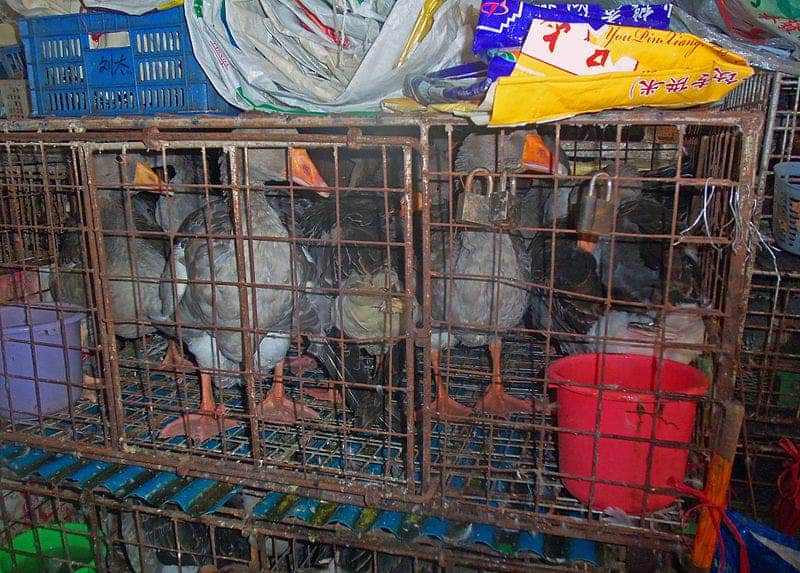China closed down some 20,000 wet markets over the course of the initial Wuhan outbreak. Now, it’s starting to reopen them, and doctors aren’t happy about it.

Wet markets, pandemics, and escalating tension
The fight is indicative of the rising tensions between China and the rest of the world: as much of the planet is struggling to deal with a wave of COVID-19 infections, China is already starting to reopen its wet markets — where many believe the pandemic originated.
It’s telling of an increasingly chauvinistic approach displayed by Beijing, a sign that the world’s most populous country is giving fewer and fewer damns about what the rest of the world is thinking.
We don’t know for sure whether SARS-CoV-2, the virus behind this pandemic, originated in a wet market. It’s a plausible and very likely possibility at this point. But here’s the thing: even if it hasn’t, wet markets are still a fertile breeding ground for viruses.
In wet markets, animals are often kept in cages, sold or even slaughtered right next to the stalls. Fruits, vegetables, and other food products are sold in close proximity. To put it extremely lightly, this doesn’t exactly make for hygienic conditions. To put it plainly, it’s a perfect environment for zoonotic viruses to jump from species to species and eventually cross the barrier to humans.
From there, the door is open to a new pandemic.
Scientists have repeatedly warned about wet markets

Animals in wet markets are penned and slaughtered or sold live right next to stalls selling fruit and vegetables. Conditions, as my colleague Adam Minter has written, are often less than hygienic.
Places where a range of common and exotic animals mix together while bodily fluids flow freely may seem a fertile breeding ground for the virulent novel diseases that cross the species barrier to humans and occasionally become pandemics.
Concerns about wet markets aren’t new. Here’s what a 2006 study concluded:
“In Chinese wet-markets, unique epicenters for transmission of potential viral pathogens, new genes may be acquired or existing genes modified through various mechanisms such as genetic reassortment, recombination and mutation. The wet-markets, at closer proximity to humans, with high viral burden or strains of higher transmission efficiency, facilitate transmission of the viruses to humans.”
This is far from an isolated study. A study published just one year ago warned about the potential of viral zoonotic diseases emerging from bats, favored by China’s unhygienic practices.
“Chinese food culture maintains that live slaughtered animals are more nutritious, and this belief may enhance viral transmission. [..] In this regard, China is a likely hotspot. The challenge is to predict when and where, so that we can try our best to prevent such outbreaks,” the study reads.
A growing chorus against wet markets
America’s top infectious expert, Anthony Fauci, has been bluntly clear about what he thinks about wet markets.
“I think we should shut down those things right away,” Fauci told “Fox & Friends.”
“It boggles my mind how when we have so many diseases that emanate out of that unusual human-animal interface, that we don’t just shut it down,” he said. “I don’t know what else has to happen to get us to appreciate that.”
Without naming any specifics (and in truth, China is far from the only country where wet markets are commonplace), Fauci continued:
“I think there are certain countries in which this is very commonplace,” he said. “I would like to see the rest of the world really lean with a lot of pressure on those countries that have that, because what we’re going through right now is a direct result of that.”
Fauci isn’t the only expert to urge China to reconsider its wet markets — and despite rising political tensions between China and the USA, all of Fauci’s statements (not just this one) have been purely based on medical science, not politics.
The problem that’s particularly prevalent in China is that wet markets also include wildlife trade. Herein lies the big problem.
In truth, only a small minority of wet markets sell wildlife, but in those that do, it’s not very uncommon to find fruits and vegetables sold alongside stingray, bears, crocodiles, porcupines, and other livestock animals.
The wet market conundrum

It’s easy to demonize wet markets and look at the risks they bring — and that much is true. But it leaves out an important part of the debate: wet markets are a place where local, underprivileged farmers can sell their produce and people can buy it.
“It would be good to ban the live animal markets as China has done and some countries. But we should also remember you have communities, particularly from low-income rural areas, particularly in Africa, which are dependent on wild animals to sustain the livelihoods of millions of people,” said Elizabeth Maruma Mrema, the acting executive secretary of the UN Convention on Biological Diversity.
“So unless we get alternatives for these communities, there might be a danger of opening up illegal trade in wild animals which currently is already leading us to the brink of extinction for some species.
Let’s not beat around the bush: there is no realistic alternative for many of these communities. In urbanizing China, wet markets are starting to lose out to westernized supermarkets and, increasingly, where wet markets survive, they survive either because they offer real value, or because there is no alternative. Simply banning wet markets can leave entire communities without a valuable (and in some cases, crucial) resource.
It’s attractive to say ‘just ban them’ — and it’s fully understandable. We don’t want another pandemic on our hand, and we know that wet markets do indeed raise the risk of zoonotic pathogens. But it’s not the markets themselves that are a problem, it’s a subset of the markets.
‘Wet market’ can mean many things in different places, but in the strictest sense, a wet market is a place where meat and fresh produce are sold — in contrast to a ‘dry market’, that sells things like textiles. In this sense, most if not all places in the world have wet markets; it’s just that in most places, the animals are already butchered, and it’s common livestock are held in more hygienic conditions.
It’s not that wet markets need to go away, it’s that they need to stop selling wildlife and ensure hygienic standards. Doing this will be challenging, but it will pose far less problems than eliminating them altogether. The Chinese government is no doubt aware of this issue, and as wet markets are starting to open across the country, we will see whether there is a commitment to ensuring safety and health, or just a desire to continue ‘business as usual’. Wildlife trade is no longer an ethical concern, nor is it an environmental one — it is a global health problem, and we need to treat it as such. Otherwise, COVID-19 will be just the trailer in a long season of pandemics.






